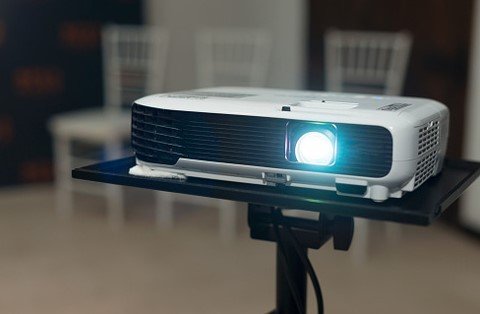Epson has launched its new Lifestudio range of portable projectors, featuring innovative RGB LED 3LCD technology for brighter and more colorful images. Announced on September 15, 2025, this lineup aims to transform home entertainment with easy setup, built in Bose sound, and smart streaming options, targeting users who want big screen experiences without complex installations.
Key Features of the Lifestudio Series
This new range includes four models split into two series, Flex and Pop, designed for different needs and budgets. Each projector uses Epson’s advanced 3LCD technology combined with RGB LED lights, which promises up to three times brighter pictures compared to many single chip DLP rivals.
The Flex series offers higher performance for serious home cinema fans. Models like the EF 72 deliver 4K resolution and ambient light effects, making them ideal for living rooms or bedrooms. On the other hand, the Pop series focuses on portability and affordability, with compact designs perfect for casual use indoors or outdoors.
All models support high dynamic range video for richer colors and contrast. They also include Bluetooth for music playback and can function as portable speakers, adding versatility beyond just projecting movies or shows.
Gamers will appreciate the auto low latency mode, which switches on when detecting a game console, ensuring smooth play without lag.

Innovative Technology and Design Choices
Epson’s move to RGB LED 3LCD in portable projectors marks a first for the brand, addressing demands for better brightness in everyday lighting conditions. This tech helps maintain vivid images even in rooms with some ambient light, a common issue with older portable models.
Design plays a big role here. The projectors come in various colors and finishes, like oak wood accents on some Flex models, to blend with home decor. Prices start at around 650 pounds for entry level options, with premium ones reaching up to 2,499 dollars, depending on the region.
A standout feature is the intelligent instant setup system. It automatically adjusts focus, keystone correction, and image position to avoid obstacles, making setup quick and hassle free.
Built in Google TV provides access to streaming apps, personalized recommendations, and voice control via Google Assistant. Users can cast content from phones or tablets easily.
To highlight the specs, here is a quick comparison table of the main models:
| Model | Resolution | Brightness (Lumens) | Key Features | Price Range (USD) |
|---|---|---|---|---|
| EF-72 (Flex) | 4K | Up to 3,600 | Ambient lights, Bose sound | 1,500-2,499 |
| EF-71 (Flex) | HD | Up to 2,000 | Auto setup, Google TV | 800-1,200 |
| EF-62 (Pop) | HD | 700-1,000 | Portable design, Bluetooth | 679-900 |
| EF-61 (Pop) | HD | 500-700 | Compact, multiple colors | 650-800 |
This table shows how the series caters to various users, from budget conscious buyers to those seeking top tier performance.
Market Impact and User Benefits
Epson, already the top selling projector brand for over two decades, is pushing into the growing portable market with this launch. Recent trends show more people opting for projectors over traditional TVs for flexible big screen setups, especially in smaller homes or for outdoor events.
The integration of Bose sound systems sets these apart, offering immersive audio without extra speakers. Dolby Audio support enhances the movie watching experience, making it feel like a mini theater.
For families, the projectors encourage shared viewing moments, countering the isolation of personal devices. With a five year warranty on many models, buyers get peace of mind for long term use.
Compared to recent launches from competitors like Sony or LG, Epson’s focus on cost effective brightness and easy setup could give it an edge. Industry reports from 2025 indicate portable projector sales are up 15 percent year over year, driven by streaming popularity.
Users report high satisfaction with similar tech in demos, noting sharp images and vibrant colors even in lit rooms.
Challenges and Considerations for Buyers
While the Lifestudio range sounds promising, potential buyers should note a few points. Brightness levels vary by model, so those in very bright spaces might prefer the higher end Flex options.
Portability is key, but battery life isn’t mentioned for all models, meaning some may need a power source for extended use outdoors.
Setup is automated, but walls or screens need to be smooth for best results. Not all models are 4K, so resolution seekers should check specs carefully.
Here are some pros and cons based on early feedback:
- Pros: Bright images, easy setup, integrated smart features, stylish designs.
- Cons: Higher prices for premium models, potential need for dark rooms for optimal viewing, limited battery on some units.
Overall, these projectors solve common pain points like complicated installations and poor sound quality.
Future Outlook for Portable Projection
This launch aligns with broader tech trends toward smarter, more integrated home devices. As 2025 progresses, expect more brands to innovate in this space, possibly with even brighter LEDs or AI enhanced features.
Epson’s entry could spark competition, leading to better options for consumers. Related events, like the recent CEDIA Expo where Epson showcased home projection tech, highlight the industry’s focus on immersive entertainment.
For now, the Lifestudio series positions Epson as a strong player in portable projectors, blending performance with user friendly design.
What do you think of Epson’s new projectors? Share your thoughts in the comments below and spread the word if this article helped you decide on your next home entertainment upgrade.








